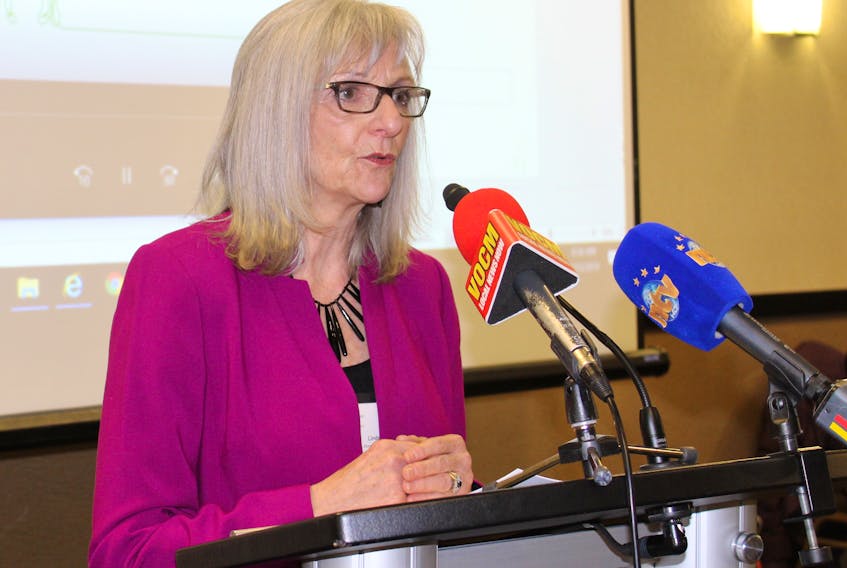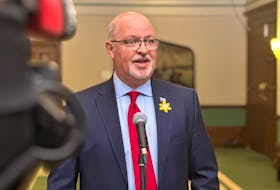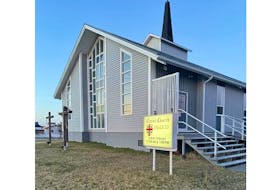More than 100 people from all walks of society and government — who have experience and knowledge of issues surrounding gender-based violence — filled the ballroom at the Capital Hotel in St. John’s on Wednesday.
Their goal is to continue to make changes as the one-year anniversary of the formation of the Minister’s Committee on Violence Against Women and Girls held a one-day symposium to look at what has been done over the past year and where they will go in the future.
The discussion will centre on what’s working well … and what isn’t.
“This is a room full of advocates, people who are sharing their experiences in an attempt to end gender-based violence,’’ said Andrew Parsons, minister of Justice and Public Safety and Attorney General and co-chair of the Minister’s Committee on Violence Against Women and Girls.
“If you see the stats, they don’t lie. We still have a lot of work to do. We need a change in the mindset, not only in justice, but in education, health, advanced education … among others,’’ he added.
"We need a change in the mindset, not only in justice, but in education, health, advanced education … among others." — Andrew Parsons
Parsons, Carol Anne Haley, the minister responsible for the Status of Women, and Linda Ross, deputy minister at the Women's Policy Office for the province, gave opening remarks to the group before they set out to gather information to help make those changes.
Clare’s Law
Parsons said he is a strong advocate of introducing a new policy that will help protect vulnerable residents.
He said people in his department likely cringed when he brought up the topic of Clare’s Law, as it might have been premature to mention it, but he is prepared to bring it to the floor of the House for debate. The purpose is to develop a policy to inform people who might not know they are in an intimate relationship with someone who has a history of violence.
“It is my hope we can get Clare’s Law in place sometime in the future here in this province,’’ he said.
“If she had the ability to find out about her partner’s previous legal issues, a disclosure of that legal history, perhaps there would have been a better outcome. This is something that could save lives. My goal is to make this happen,’’ he added.
Clare’s Law originated in the United Kingdom and is named for Clare Wood, who in 2009 was murdered by her ex-boyfriend in the Greater Manchester area.
The U.K.’s 2014 Domestic Violence Disclosure Scheme, a.k.a. Clare’s Law, will allow a partner or a concerned third party to request information from police about a potential perpetrator’s criminal record.
Saskatchewan was the first Canadian province to introduce legislation — in December 2017 — allowing police to warn partners of someone’s violent or abusive past.
Parsons hopes Newfoundland and Labrador will be open to following suit.
How to make change
Healy said the group and the province have to work hard to make changes that will protect the most vulnerable, at-risk people in the community.
“I am asking you here today, ‘What can we do, what can you do, to prevent violence?’” Healy said.
“I am excited about what we can accomplish together to prevent violence against this vulnerable sector of society,’’ she added.
Ross, who has a long history of advocating for changes in the battle against violence against women and girls, agrees there is a monumental task ahead of the group.
She outlined a host of statistics that included only five per cent of sexual assaults being reported to police, and indigenous women being 3 ½ times more likely to be victims of violence, as part of the staggering list of examples of violence.
“Clearly we accomplish more as a group. I know we are just giving a top of the trees overview of what is going on here, as there is a lot more happening, but if we build on what we did, it just may make a difference,’’ Ross added.
“The plan is, we are in it, so do it together.’’
Some of the highlights from the past year include adjustments to the Residential Tenancies Act, Labour Standards Act, Family Violence Protection Act, Federation of Labour supports, delivery of the Schools Act and the Provincial Advisory Council on the Status of Women — all aimed at making changes that will help advance the causes of those affected by violence and ultimately helping them achieve better and swifter outcomes.
“Policing agencies have reorganized. The RNC and RCMP are at the table making it mandatory for frontline officers to get training aimed at the health, mental health and safety of our citizens,’’ she said.
“If we can gather solutions-based information, and act on it, we will make that difference.”
Throughout the day, the assigned groups discussed several themes of action, which included education and awareness, culturally appropriate responses, integrated and holistic services, and innovative approaches, all aimed at addressing the issue of violence against women and girls.









